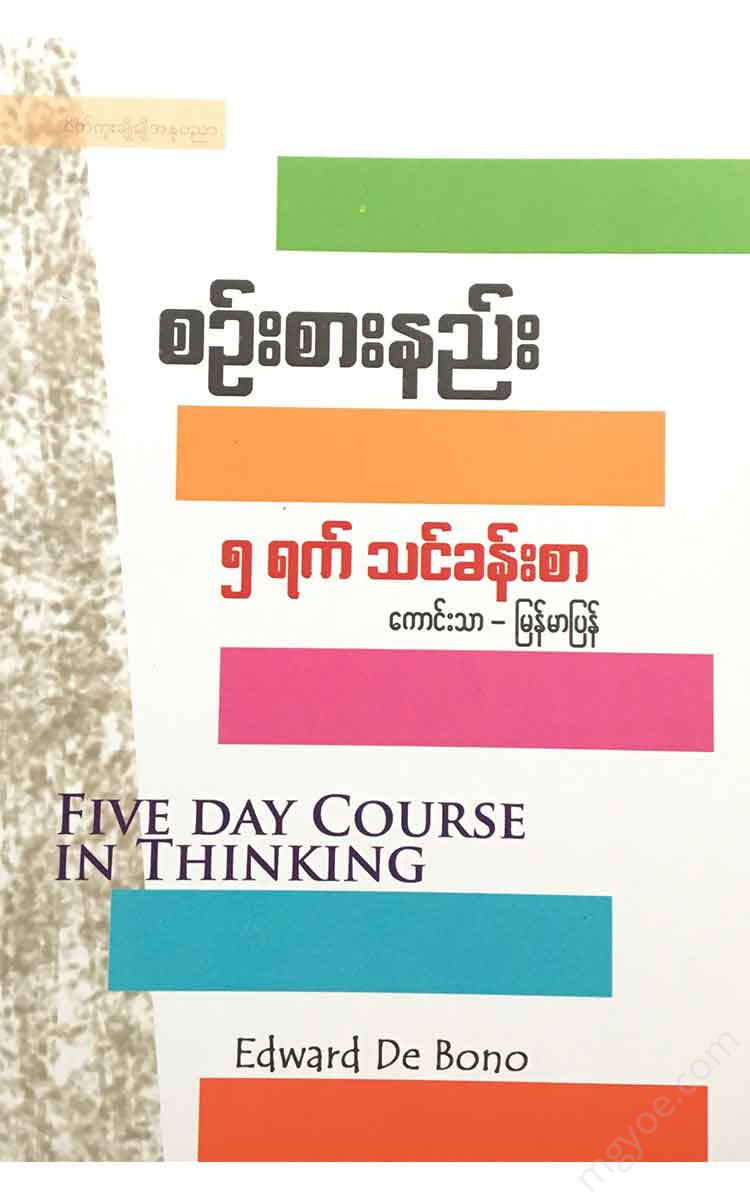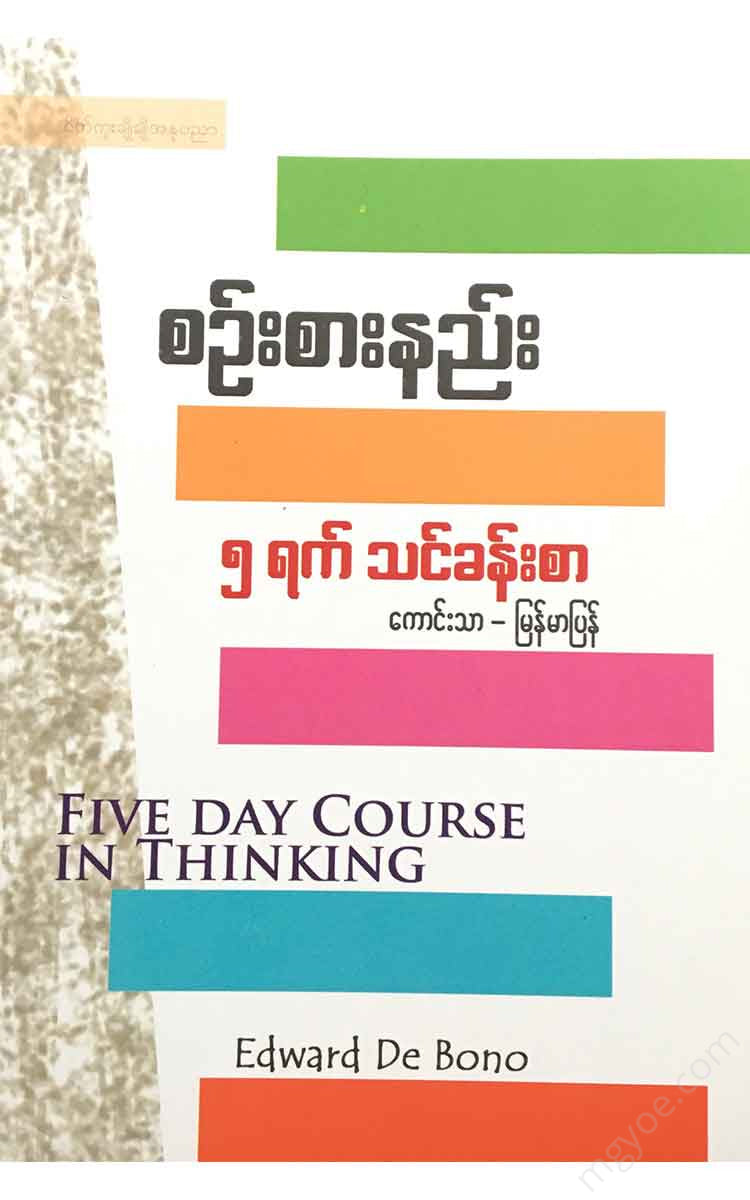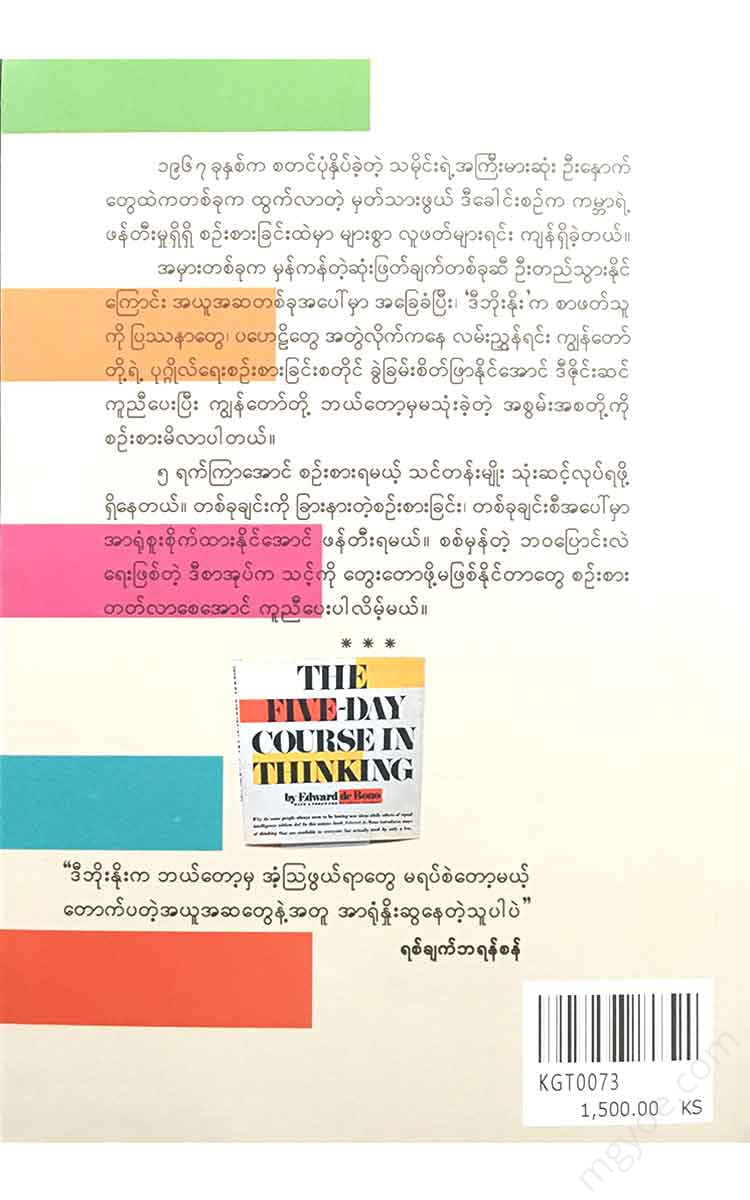စိတ်ကူးချိုချိုစာပေ
Good - How to Think (5) Day Lesson
Good - How to Think (5) Day Lesson
Couldn't load pickup availability
Introduction
The course starts tomorrow, and nothing has been done so far | Your thinking should be as clear and effective as possible. Think about its current excellence, but look forward to further improvement from this immediate excellence. Expect to attend this course with something to demonstrate or doubt such excellence.
Opportunities to practice your thinking should be practical rather than imaginative. This is a hands-on course, so you will need to gather your tools. • Beer or soft drink bottle caps
4 blanks. 4 thin table knives, (the handle and the knife should be flat and the blade should be rounded so that it doesn't get cut) 1 glass filled with water.///
First day
Problem (1)
Place three bottles upright on a table or the floor. Place one bottle at each of the three corners of an isosceles triangle. The distance between the bases of the two bottles should be slightly more than the length of a knife. No part of any of the knives should touch the ground. The base should be strong enough to support a glass full of water.
The problem is this. You can approach it however you like. You can attack it logically. You can play around with knives and make something appear. You can wait and see if a solution appears. So you can find it. You can even decide that there is no solution to this problem.
As you work on the problem, you need to evaluate the solution. Evaluate how long it will take. Evaluate how you will approach it. Evaluate what you will do differently from the approach you are using and think about why you should use it. Evaluate how a particular approach will end up blocking you. Evaluate how many solutions there are, and if there are any. If there are no solutions, evaluate how long it will take you to figure it out and think about how confident you are in your decision.
The problem is intended as an opportunity to consider your thinking. There are no explicit demands for a solution.
Even if you are still unsuccessful at the end of today, you can choose to sleep on this problem and find a solution by reading the next chapter.
Solution to the 3-bottle problem
Once laid out, it's clear that the solution will require some time and effort to be truly amazing.
First, set aside 1 of the 4 knives. Just because you can't use more than 4 knives doesn't mean you have to use all 4 knives. A common mistake that can happen is to plan to do something and then continue to implement that plan. If you base your plan on the wrong one, then you can't use any great thinking.
The interlocking blade arrangement provides the solution shown above (Figure 1).
A solid triangular platform was created between the bottles. The tops of the bottles were turned upwards. A glass filled with water (the dropper circle) was placed in the center of the platform.
The solution is simple enough. Just get to the bottles with your knives. Why would a solution be so simple? It's a ready-made solution of experience.
Because we are thinking about using more context. When we come to a context like this for this problem, the solution really becomes easier.
Some obvious and relevant issues are likely to be more affected by the solutions they can help with. The distance between the two bottles is greater than the length of a knife, so we need to use two knives between the two bottles. We need to connect the two knives to get a long length. But there is nothing to connect.
You can evaluate the angles as if they were pointing towards the center of the triangle. This is natural, so it becomes the final solution.
Every individual's brain processes are highly personal. Habits, experiences, and even attitudes all have their own unique influences. Misguided approaches, brain blockages, and lack of mental stimulation can occur. Misguided beliefs and a lack of confidence often result.
The final solution comes as a matter of logical effort and chance. No one should have any difficulty understanding the simplicity of the solution.
For all those who can solve problems with incredible speed, we should take personal lessons from a real-life brain process that is more valuable than a solution.
Some people may try to use logic when trying to solve problems. However, if there is no clear path, logic can lead to wrong paths, which can delay decisions and lead to unnecessary actions.
Others may prefer to think as they come. This kind of thinking requires no direction, no direction. It is also impossible to control. Ideas can emerge as you play with the blades and move them around. You can discard each idea you try as it becomes useless. Even if you discard it, new ideas can still emerge from the failures. This can be a long, wasteful process. But it often leads to the right solution. Especially if there is no obvious logical way forward.
The following are some things worth noting during your first day experience.
1. It is important not to take items that will be insured in an outdoor setting.
2. Experience has shown that if the scenarios are not prepared, a solution can be found.
Approaches can be difficult.
3. The plots prepared based on experience or intuition
If it is not relevant, it may hinder problem solving.
4. The process of trial and error can be as effective as logic.
This remarkable title, first published in 1967 by one of history's greatest minds, has remained a staple in the creative thinking of the world.
Based on the idea that a mistake can lead to a right decision, De Bono guides the reader through a series of problems and puzzles, designed to help us analyze our personal thinking styles and discover strengths we never used.
There are three stages of the 5-day thinking course. Each one requires a different mindset, each one focused on. This truly life-changing book will help you think about the impossible.
THE FIVE-DAY COURSE IN TIIINKING
“ This guy is a man who never ceases to amaze with his brilliant ideas.”
Richard Branson











